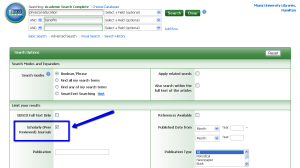CJS 485 Conover (Hamilton): Peer-Reviewed/Scholarly Journal Articles
Peer-Reviewed/Scholarly Journal Articles
There are many terms for peer-reviewed articles and journals, such as: scholarly, refereed, and professional. All of these terms mean the same thing and are interchangeable. Finding these types of articles is not as difficult as one might think. There are several things you can look for to help determine if an article is peer-reviewed or scholarly.
- Length: Scholarly journal articles will be much longer than magazine or regular journal articles.
- Vocabulary: These articles are intended to be read by people already in this field of study or students who are preparing for this field. Therefore, authors of these articles will often use jargon and terms associated with that field.
- Research: These articles will also include some research information--either from original research (in which case they will provide information on how the study was conducted), or research gathered from other sources (if this is the case, you will see a resources list--much like a “Works Cited” page).
There are other clues you can look for to determine whether an article is scholarly, but those are the main ways to tell. In most databases, you will see an option on the search page to limit to peer-reviewed articles (as shown in the picture below). Using this option on the search page will weed out articles from your results list that are not peer-reviewed.
The video below explains what a peer-reviewed/scholarly article is and describes the differences between scholarly/peer-reviewed articles and other articles.
Scholarly vs. Popular Articles
| Scholarly | Popular | |
| Audience | Experts, researchers, professors | Lay people, the general public |
| Authors | Experts and researchers, has credentials in the field | Journalists and generalists |
| Language | Technical terminology, jargon of the discipline | Everyday language for general readers |
| References | Bibliography included | Probably no bibliography |
| Research | Authors reporting on their own original research | Author is a journalist who may have interviewed the researcher, but did not conduct the lab work or do the theoretical analysis himself |
| Look and Feel | Dull looking, few or no ads, graphics are charts, graphs, maps, etc. that support data | Glossy paper, color, lots of graphics, images, ads |
| Publication Schedule | Generally published monthly or less often (quarterly, bimonthly, etc.) | Generally published monthly or more often (biweekly, weekly) |
| Pagination | Entire volume is paged continuously (if issue 1 ends on page 215, issue 2 will begin on page 216) | Each issue is paged separately |
Tutorials and Videos
Peer Review (video)
How to Read Scholarly Materials (tutorial)
